Las Vegas is an oasis of indulgence in the middle of the Mojave Desert, and most who visit this air-conditioned fantasyland stay within the casino-lined, four-mile length of the Las Vegas Strip. What many are beginning to realize — and locals have long known — is that the nearby deserts, dunes, and mountain ranges are a jackpot all their own. Hiking, camping, rock climbing, mountain biking, off-roading, and even skiing are all possible within an hour of the Strip. The beauty of the surrounding desert landscape offers a peaceful reprieve from the high-energy noise of the casino floor, so trade in your poker visor for a wide-brimmed sun hat. You’re in for a different type of Vegas thrill this time around.
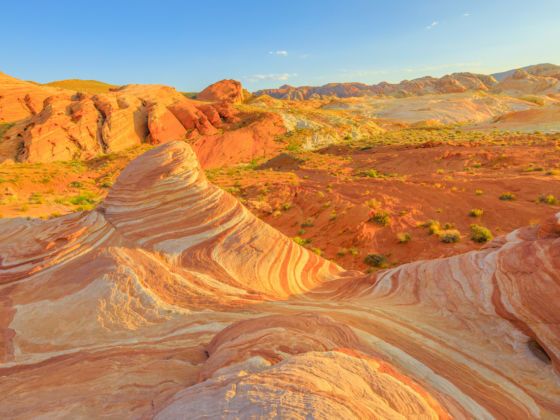
Skip the Strip to Enjoy All the Nature Las Vegas Has to Offer
Red Rock Canyon
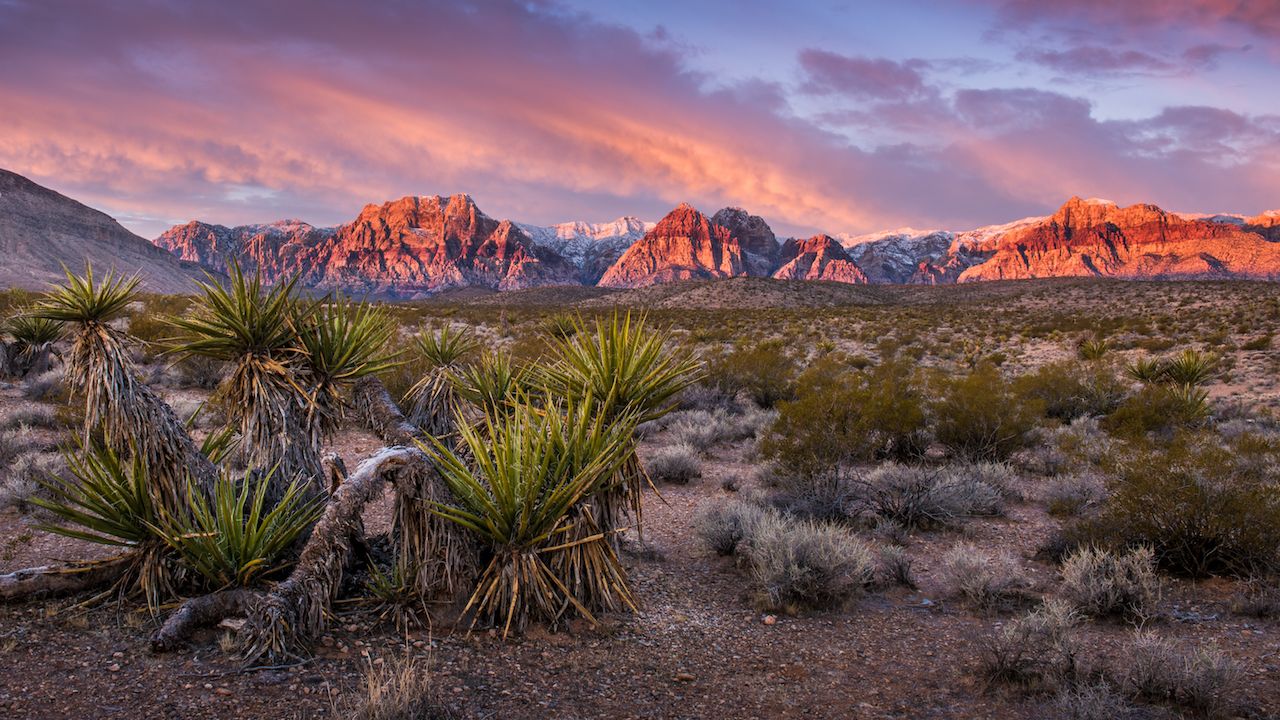
Photo: William Ducklow/Shutterstock
Red Rock Canyon is Las Vegas’ closest and quite possibly most beautiful natural playground. This 13-mile scenic drive 30 minutes from central Las Vegas is popular for multiple outdoor activities, including its 26 hiking trails, campgrounds, horseback riding, and cultural landmarks all surrounded by the canyon’s namesake red Aztec sandstone cliffs. Hikers of all skill levels can easily spend a day winding through Red Rock’s many canyons and springs, which are home to unique desert flora and fauna, as well as 800-year old indigenous petroglyph rock art.
Rock climbers consider Red Rock Canyon among the finest climbing destinations in the country — with seemingly endless intermediate-level traditional, sport, and bouldering routes. The Red Rock Loop is often lined with cyclists on a beautiful day, and mountain bikers can venture off the main loop on designated trails like the Cottonwood Valley Trails System or the Twilight Zone Trails for a more intimate experience with the area’s plant and animal life.
Those seeking a more relaxing experience should not miss Spring Mountain Ranch State Park. This serene park was once a ranch and luxury estate owned by famed German actress Vera Krupp and later by infamous Las Vegas magnate Howard Hughes. You can tour the historic building, enjoy a picnic, or hike through the picture-perfect grounds. Every summer, the park hosts its Super Summer Theatre program, where Las Vegas’s finest professional and amateur actors and actresses perform everything from Shakespeare to musicals. Bring a picnic basket and watch the mountains change to every shade of purple with the sunset before the show begins. Few Vegas attractions can compare to it.
Mt. Charleston
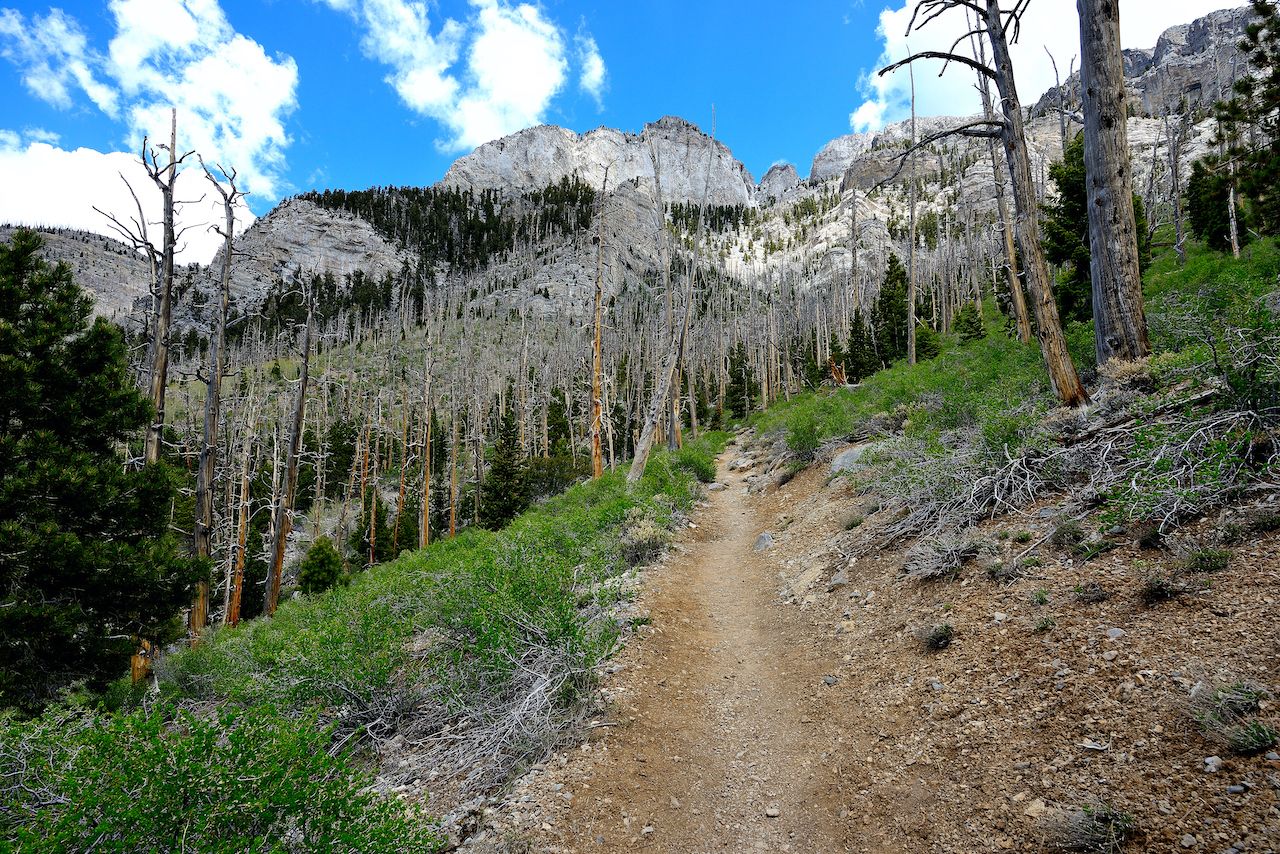
Photo: Eric M. Williams/Shutterstock
A short, 45-minute drive from Las Vegas lies every local’s favorite summer and winter escape: Mt. Charleston. The 11,916-foot peak, the tallest in the area, is part of the Spring Mountains National Recreation Area and is reliably 20 to 30 degrees cooler than Las Vegas — a blessing when summer temperatures reach 110 degrees and beyond. In the winter, Mt. Charleston is one of the most accessible areas in Southern Nevada with significant snowfall, drawing families with sleds as well as skiers and snowboarders ready to tear up the slopes at Lee Canyon Ski Resort.
Hiking trails at Mt. Charleston are plentiful and often under-utilized. The Mary Jane Falls Trail is a popular choice, at 3.2 miles round-trip with nine switchbacks culminating in a gorgeous natural waterfall. Another highlight is the Cathedral Rock Trail, a slightly more difficult path that slowly rises through lush ponderosa, white fir, and aspen trees, past yet another waterfall to a splendid view of the surrounding Kyle Canyon area.
For those seeking to conquer the summit of Charleston Peak, you have two options: the South Loop Trail and North Loop Trail, both well-maintained and well-traveled. Veterans of this strenuous adventure can spend an entire day on this 16-mile journey. The climb takes you up 4,000 feet, so make sure you are well prepared and adjusted to the altitude before attempting. The reward for all this hard work? A breathtaking panoramic view that stretches from Las Vegas to Death Valley to the Sierra Nevada on a clear day. Celebrate your achievement with a bowl of chili and a tall glass of your preferred libation at the Mt. Charleston Lodge. You’ve earned it.
Valley of Fire State Park
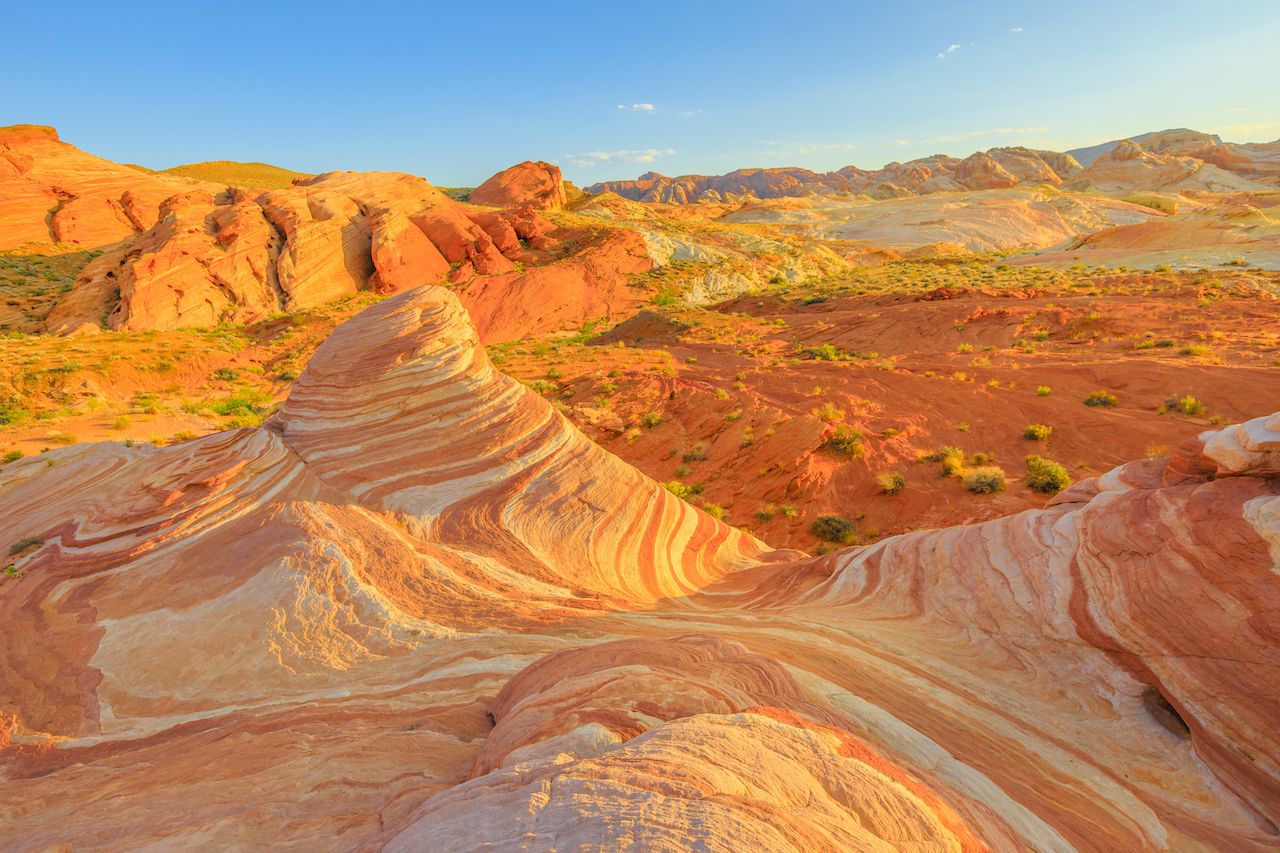
Photo: Benny Marty/Shutterstock
An hour north-east of Las Vegas lies an alien landscape known to us Earthlings as Valley of Fire State Park. This 40,000-acre area of vivid red sandstone looks like it came straight out of the Star Wars universe, an appearance enhanced by the way wind and water erosion shaped the rock face into smooth and twisted natural monuments over thousands of years. This area truly has an ancient feel — scattered around the park grounds are remnants of petrified trees that date back 150 million years. In more recent history, many trails in the park wind past 2,000-year old petroglyphs that allude to the intelligent and complex peoples that called this place home.
Hiking and camping are the primary attractions at Valley of Fire, making this location perfect for a quick day trip or a place to spend a few quiet desert nights. There are 72 first-come, first-served camping spaces across two campgrounds equipped with tables, grills, water, restrooms, and RV hookups. The natural wonders of the park are easily enjoyed by hiking trails like the splendidly Instagramable Beehives, a sandstone rock formation that is among the most iconic photo spots in the area. Similar in appearance to the kind of beehive you’d see stuck on Winnie the Pooh’s head (if he was 50 feet tall), these formations are the result of a geologic process called cross-bedding, during which minerals are deposited in angled levels by wind or water over time. There may not be honey in these beehives, but they remain a sweet visual experience.
Due to the nature of the sandstone in the area, rock climbing is not widely practiced here. Light scrambles across the terrain are more common, like the sort found at the park’s famed Elephant Rock Loop. The light 1.2-mile loop off the main road takes one up the rock face to a tremendous formation eroded into the shape of an elephant with discernable trunk, mouth, and legs. Much like an elephant, this sight is surely one you’ll never forget.
And that’s just the beginning
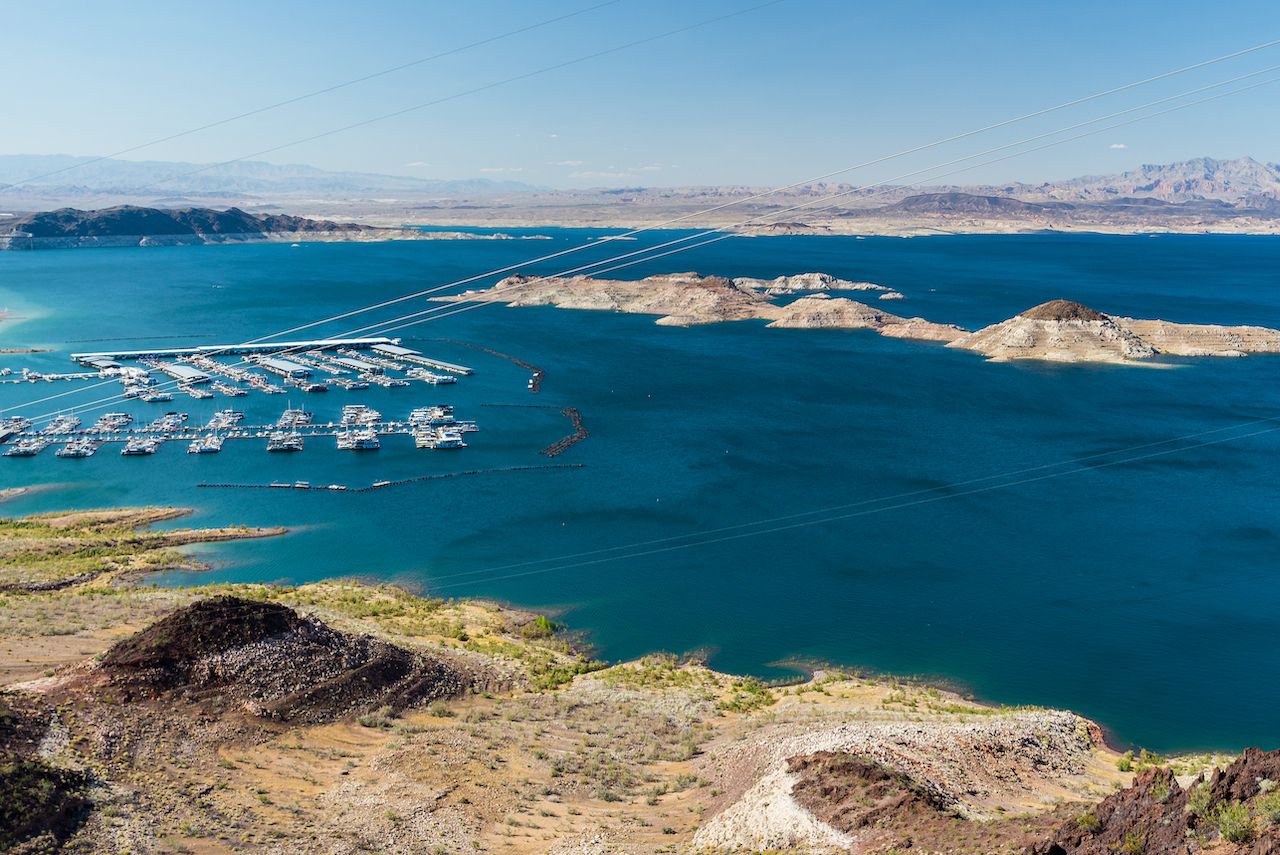
Photo: blazg/Shutterstock
Sixty-three percent of the land in Nevada is public land controlled by the Bureau of Land Management. As such, the possibilities for exploration and discovery are practically endless for those seeking their own private corner of underappreciated desert beauty.
The Lake Mead National Recreation Area, including the area around the Hoover Dam, offers an array of outdoor activities including kayaking, boating, and fishing. A favorite hike near the Hoover Dam is the Goldstrike Hot Springs scramble. Hot springs can be found in many parts of Southern Nevada and are a great (clothing-optional) way to relax your muscles at the end of rewarding trails like this one.
For a more cultured desert experience, the ghost town of Rhyolite near Death Valley contains both the ruins of a 100-year-old gold mining town as well as the contemporary Goldwell Open Air Museum. This museum is home to brightly colored abstract sculptures — including a ghostly “Last Supper” by Albert Szukalski and the nude “Lady Desert: The Venus of Nevada” by Hugo Heyrman, constructed out of pink and yellow cinder blocks — that are so out of place in their sparse surroundings that they somehow seem as if they’ve always been there.
Similarly, the Seven Magic Mountains along Interstate 15 entering Las Vegas from California are not to be missed. These 30-foot-tall, neon-tinted rock towers attract a multitude of visitors (Beyonce and Jay-Z were recently spotted taking in the sight) and are on display through 2021. The artificial, arguably ugly tones of Ugo Rondinone’s installation can be interpreted in any which way you desire, though the way the piece reflects the foreign and tenacious quality of Las Vegas — a bright spot of neon in a sea of desert reds, grays, and browns — will hopefully jog your imagination. With a head full of culture, head to the Pioneer Saloon in nearby Goodsprings, a former mining town better known today for having one of the best burgers in the state. You’ll need the fuel for the many adventures that lie ahead.